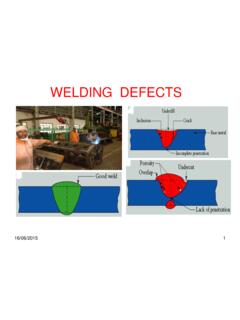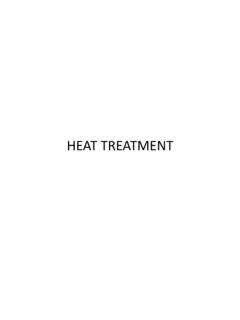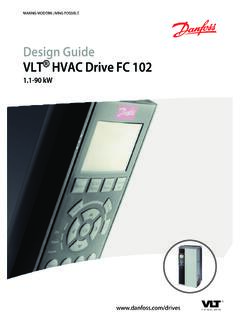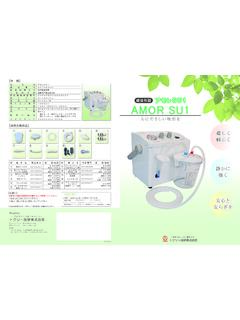Transcription of PAINTS, ITS CONSTITUENTS & FUNCTION
1 PAINTS, ITS CONSTITUENTS &. FUNCTION . OBJECTIVES. To: Understand the: Definition & properties of paint CONSTITUENTS of paint, their properties &. functions PAINT. Definition: Paint is defined as a unique homogeneous mixture of three major ingredients namely Binder, Pigment, VOC & additives, which when applied on the surface as a thin layer that forms a solid dry adherent film after oxidation/evaporation/ polymerisation . In the broadest terms, a paint consists of a particular pigment, dispersed in a particular binder, dissolved in a particular solvent In general the corrosion protection afforded by a paint film is to its DFT measured by Elcometer-an electro-magnetic induction gauge *Adhesion: the degree of attachment between film & the substrate PROPERTIES OF PAINT.
2 Properties: It should have high hiding power & the required colour It should be able to resist the atmospheric conditions to which it will be put The films produced should be washable It should resist corrosion It should have the necessary consistency (property to resist permanent change of shape) for a particular purpose for which the paint is to be used The film produced by applying the paint on a surface should have gloss *All the requirements can be obtained in a paint by properly choosing the proper pigments, extenders, binders and their quantities. There is no set methods for doing so.
3 PURPOSE OF PAINT. Purpose: To avoid loss of metal due to corrosion Protects the metal surfaces from the corrosive effects of weather (sun, wind, rain, frost, atmospheric pollution & other natural elements), heat, moisture, gases etc. Delays in rusting Provides: aesthetic look to materials a smooth surface for easy cleaning CONSTITUENTS OF PAINT. Paints are variable combinations of :- Binder Pigment Filler/ Extender Volatile organic compound (Thinner). Driers Additives (Anti skinning agents, Anti settling agent, Plasticizers, fire retardants etc 16/06/2015 6. BINDER.)
4 Binders are usually resins or oils but can be inorganic compounds . The actual film forming component & absolutely required ingredient of any paint . Consists of a resin and a solvent thinner It is the part which solidifies to form the dry paint film when the solvent evaporates Non-volatile & mainly polymers of various types. They are alkyd, epoxy, polyurethane resins etc Different resins form dry film on the substrate in different manners Alkyd resins (widely used binders) form dry film simply by volatilization as well as by oxidation in presence of air Epoxy & PU resin mainly dry through chemical reactions 16/06/2015 7.
5 BINDER. Purpose: Binds pigment, fillers &. additives together Binder Imparts adhesion & strongly influences: Gloss Durability Flexibility Toughness Binders include resins:- Alkyds, Polyurethanes (PU), Epoxy, Polyesters 16/06/2015 8. PIGMENTS. Pigments are finely ground inorganic or organic powders of higher RI (> ). Higher the RI, more the light is bent & greater the opacity Good opacity has good lighting absorbing & /or scattering properties HIDING POWER. Average diameter ranges from to 5 . 16/06/2015 9. PROPERTIES OF PIGMENT. Should be opaque so that it may have good covering power.
6 When a coating is opaque the pigment particles scatter &/or absorb light sufficiently to prevent it from reaching the substrate Opacity depends on two characteristic properties: Refractive Index (RI). If the particles do not have a high RI, less the bending of light travelling & thus insufficient hiding of the substrate. Particle size: Particle size has also an effect on the effectiveness of the pigment. As the particle size decreases , opacifying ability increases. Should be non-toxic so that they have no bad effect on health of painter & inhabitants PURPOSE OF PIGMENT.
7 Purpose: Pigment plays a major role to attain the following essential properties of paint system provides colour, opacity, film cohesion and sometimes corrosion inhibition provides aesthetic look to the paint obliterates the substrate and previous colour on the substrate, if any protects the film by reflecting the destructive UV. light PIGMENTS. Widely used pigments: White Lead, Zinc Oxide, Titanium Dioxide, Red Oxide, Carbon Black, Prussian Blue, Chrome Yellow, Aluminium powder etc. * [Titanium dioxide is extensively used because it has good covering power). Titanium is an excellent reflector of infrared].
8 16/06/2015 12. EXTENDER/FILLER. Non-expensive commonly natural inorganic materials added to the paint in order to increase its volume.(RI < ). Extenders are mainly inorganic substances & do not provide colour to the paint but added to improve adhesion, ease of sanding and film strength As they are cheap in comparison to prime pigments, they reduce overall cost of the paints Average dia: up to 50 . 16/06/2015 13. EXTENDER/FILLER. Properties: Do not provide colour Poor optical properties (reflectance, opacity, etc). It improves adhesion If extender pigment added are of needle shaped or flaked shape, the settling may be very little Purpose: thickens the film Increases volume, paint film thickness reduces cost of the paint imparts toughness, abrasion resistance & texture Control consistency Widely used fillers:- Calcium carbonate, Gypsum, Ground silica, Barytes, Slate powder ,French chalk, china clay, asbestos, silica, mica, whiting etc.
9 VOC/THINNER. Liquid used for viscosity adjustment for correct application . Used to dissolve the binder and to facilitate application of paint. Solvents are usually organic liquids or water. not a part of the paint film. Excessive thinner dulls the colour & gloss Most hazardous due to its toxicity & flammability Once the solvent gets evaporated, the remaining paint is fixed on to the surface Purpose:- Control flow and application properties Act as carrier for binders & pigments Help penetration into porous surfaces 16/06/2015. Used to clean brushes & other painting tools 15.
10 VOC/THINNER. Widely used thinner: Turpentine oil (distilled pine tree sap): the most commonly used thinner Benzene & Naphtha: as substitute. Mineral spirit, acetone, carbon tetra chloride, ethyl alcohol DRIERS. Depending upon the nature of the solvent and film thickness, the drying process may take as long as several hours. Thicker the film, longer the drying time. If the drying process is artificially accelerated, there may be problems with adhesion between the protective film and the metal surface. Metallic salts of Lead, Manganese, Cobalt, etc. of organic acids Easily soluble at ordinary temp Added in small quantity One drier should be used at a time Added to the paint just before use.










